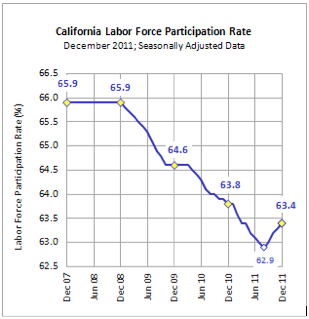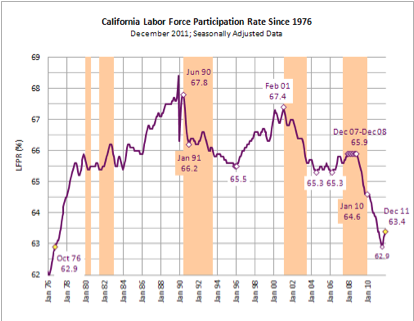Increasing over the past few months, as the unemployment rate has declined nationally and in California, question has arisen: How much of the drop in the unemployment rate is due to a growth in jobs, and how much is due to workers leaving the labor force. The short answer is that there are elements of both. Let’s briefly examine the California data.
The unemployment rate is a measurement of the number of workers unemployed (numerator) over the number of workers in the labor force (denominator). This denominator is not constant. At any time, workers are entering and exiting the labor force.
Once again, we turn to EDD’s Labor Market Information Division, and are assisted in our inquiry by economist Paul Wessen. The chart below shows the labor force participation rate in California since December 2007, when the Great Recession begin to hit in force. The labor force participation rate dropped from 65.9% in December 2007 pretty steadily until it reached a low of 62.9% in August 2011. Since that time it has rebounded to reach 63.4% in December 2011.
California’s drop in labor force participation is not unique to the state, but follows the drop in the labor force participation rate nationwide. In December 2007, the nation’s labor force participation rate stood at 66%. It also went down in the next four years, though not as sharply as in California, and stood at 64% in December 2011.
What are we to make of these data? Economist Wessen notes that the labor force participation rate has declined in California at various times since 1976, as shown in the chart below.
The rate generally increased during the 1970s and 1980s in California as women entered the labor force in greater percentages. It reached a high of 67.8% in June 1990, and reached 67.4% in February 2001. After reaching these highs, the rate declined. The rate of 62.9% in August 2011, though, was the lowest since October 1976.
The seasonally-adjusted Civilian Labor Force in California stood at 18,219,000 in December 2011. This number represented a gain in the Civilian Labor Force over the year, after two years in which the Civilian Labor Force actually declined or showed no annual gain. At the same time, the increase of 68,000 workers from December 2010 through December 2011 was considerably less than the increases in the pre-Great Recession years of 2004-2005 (182,000 workers added to the Labor Force) and 2005-2006 (221,000 workers added to the Labor Force).
Starting when the state employment numbers for January are released next Friday and continuing over the next month, we will want to track the Civilian Labor Force numbers, along with the unemployment rate and other indicators.


